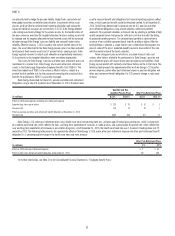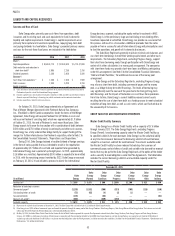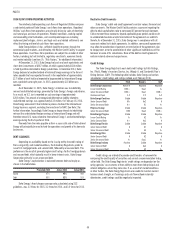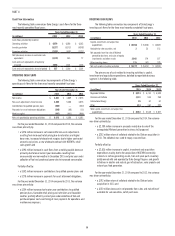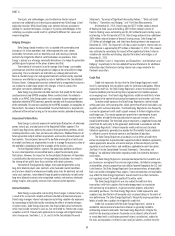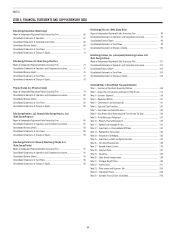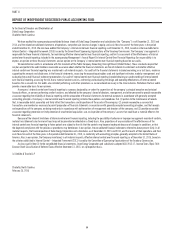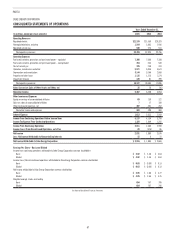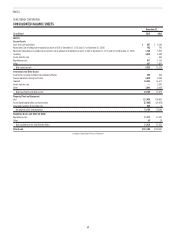Duke Energy 2015 Annual Report Download - page 80
Download and view the complete annual report
Please find page 80 of the 2015 Duke Energy annual report below. You can navigate through the pages in the report by either clicking on the pages listed below, or by using the keyword search tool below to find specific information within the annual report.
60
PART II
The inputs and methodologies used to determine the fair value of
contracts are validated by an internal group separate from Duke Energy’s deal
origination function. While Duke Energy uses common industry practices to
develop its valuation techniques, changes in its pricing methodologies or the
underlying assumptions could result in significantly different fair values and
income recognition.
Hedging Strategies
Duke Energy closely monitors risks associated with commodity price
changes on its future operations and, where appropriate, uses various
commodity instruments such as electricity, coal and natural gas forward
contracts to mitigate the effect of such fluctuations on operations. Duke
Energy’s primary use of energy commodity derivatives is to hedge the generation
portfolio against exposure to the prices of power and fuel.
The majority of instruments used to manage Duke Energy’s commodity
price exposure are either not designated as hedges or do not qualify for hedge
accounting. These instruments are referred to as undesignated contracts.
Mark-to-market changes for undesignated contracts entered into by regulated
businesses are reflected as regulatory assets or liabilities on the Consolidated
Balance Sheets. Undesignated contracts entered into by unregulated businesses
are marked-to-market each period, with changes in the fair value of the
derivative instruments reflected in earnings.
Duke Energy may also enter into other contracts that qualify for the normal
purchase/normal sale (NPNS) exception. When a contract meets the criteria to
qualify as an NPNS, Duke Energy applies such exception. Income recognition and
realization related to NPNS contracts generally coincide with the physical delivery
of the commodity. For contracts qualifying for the NPNS exception, no recognition of
the contract’s fair value in the Consolidated Financial Statements is required until
settlement of the contract as long as the transaction remains probable of occurring.
Generation Portfolio Risks
Duke Energy is primarily exposed to market price fluctuations of wholesale
power, natural gas, and coal prices in the Regulated Utilities segment. The
Duke Energy Registrants optimize the value of their generation portfolios, which
include generation assets, fuel, and emission allowances. Modeled forecasts of
future generation output and fuel requirements are based on forward power and
fuel markets. The component pieces of the portfolio are bought and sold based
on models and forecasts of generation in order to manage the economic value of
the portfolio in accordance with the strategies of the business units.
For the Regulated Utilities segment, the generation portfolio not utilized
to serve retail operations or committed load is subject to commodity price
fluctuations. However, the impact on the Consolidated Statements of Operations
is partially offset by mechanisms in these regulated jurisdictions that result in
the sharing of net profits from these activities with retail customers.
International Energy generally hedges their expected generation using
long-term bilateral power sales contracts when favorable market conditions
exist and are subject to wholesale commodity price risks for electricity not sold
under such contracts. International Energy dispatches electricity not sold under
long-term bilateral contracts into unregulated markets and receives wholesale
energy margins and capacity revenues from national system operators.
Interest Rate Risk
Duke Energy is exposed to risk resulting from changes in interest rates as
a result of its issuance of variable and fixed-rate debt and commercial paper.
Duke Energy manages interest rate exposure by limiting variable-rate exposures
to a percentage of total debt and by monitoring the effects of market changes
in interest rates. Duke Energy also enters into financial derivative instruments,
which may include instruments such as, but not limited to, interest rate swaps,
swaptions and U.S. Treasury lock agreements to manage and mitigate interest
rate risk exposure. See Notes 1, 6, 14, and 16 to the Consolidated Financial
Statements, “Summary of Significant Accounting Policies,” “Debt and Credit
Facilities,” “Derivatives and Hedging,” and “Fair Value Measurements.”
At December 31, 2015, Duke Energy had $727 million notional amount
of floating-to-fixed swaps outstanding, $500 million notional amount of
fixed-to-floating swaps outstanding and $1,300 million forward-starting swaps
outstanding. In the first quarter of 2016, Duke Energy entered into an additional
$500 million notional amount of forward-starting swaps. Duke Energy had
$7.9 billion of unhedged long- and short-term floating interest rate exposure at
December 31, 2015. The impact of a 100 basis point change in interest rates on
pretax income is approximately $79 million at December 31, 2015. This amount
was estimated by considering the impact of the hypothetical interest rates on
variable-rate securities outstanding, adjusted for interest rate hedges as of
December 31, 2015.
See Notes 2 and 14, “Acquisitions and Dispositions” and Derivatives and
Hedging,” respectively, to the Consolidated Financial Statements for additional
information about the forward-starting interest rate swaps related to the
Piedmont acquisition.
Credit Risk
Credit risk represents the loss that the Duke Energy Registrants would
incur if a counterparty fails to perform under its contractual obligations. Where
exposed to credit risk, the Duke Energy Registrants analyze the counterparty’s
financial condition prior to entering into an agreement and monitor exposure
on an ongoing basis. The Duke Energy Registrants establish credit limits where
appropriate in the context of contractual arrangements and monitor such limits.
To reduce credit exposure, the Duke Energy Registrants seek to include
netting provisions with counterparties which permit the offset of receivables and
payables with such counterparties. The Duke Energy Registrants also frequently
use master agreements with credit support annexes to further mitigate certain
credit exposures. The master agreements provide for a counterparty to post
cash or letters of credit to the exposed party for exposure in excess of an
established threshold. The threshold amount represents a negotiated unsecured
credit limit for each party to the agreement, determined in accordance with the
Duke Energy Registrants’ internal corporate credit practices and standards.
Collateral agreements generally also provide that the inability to post collateral
is sufficient cause to terminate contracts and liquidate all positions.
The Duke Energy Registrants also obtain cash or letters of credit from
certain counterparties to provide credit support outside of collateral agreements,
where appropriate, based on a financial analysis of the counterparty and the
regulatory or contractual terms and conditions applicable to each transaction.
See Note 14 to the Consolidated Financial Statements, “Derivatives and
Hedging,” for additional information regarding credit risk related to derivative
instruments.
The Duke Energy Registrants’ principal counterparties for its electric and
gas businesses are regional transmission organizations, distribution companies,
municipalities, electric cooperatives and utilities located throughout the U.S. and
Latin America. The Duke Energy Registrants have concentrations of receivables
from such entities throughout these regions. These concentrations of receivables
may affect the Duke Energy Registrants’ overall credit risk in that risk factors
can negatively impact the credit quality of the entire sector.
The Duke Energy Registrants are also subject to credit risk from
transactions with their suppliers that involve prepayments in conjunction
with outsourcing arrangements, major construction projects and certain
commodity purchases. The Duke Energy Registrants’ credit exposure to such
suppliers may take the form of increased costs or project delays in the event of
non-performance. The Duke Energy Registrants’ frequently require guarantees or
letters of credit from suppliers to mitigate this credit risk.
Credit risk associated with the Duke Energy Registrants’ service to
residential, commercial and industrial customers is generally limited to
outstanding accounts receivable. The Duke Energy Registrants mitigate this
credit risk by requiring customers to provide a cash deposit, letter of credit
or surety bond until a satisfactory payment history is established, subject to
the rules and regulations in effect in each retail jurisdiction, at which time the




